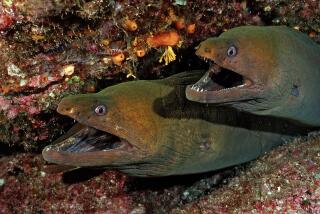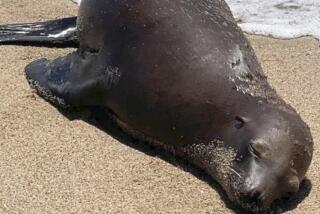SEAL BEACH : Whale’s Death Tied to Natural Causes
Biologists on Monday dissected a 15-ton gray whale that washed ashore during the weekend and concluded that it probably died of disease or natural causes.
The 38-foot mammal washed ashore Sunday night, becoming the second dead whale to land on Orange County beaches this year. In February, an 18-foot gray whale was found near Laguna Beach’s Victoria Beach, and authorities determined that its death may have been caused by a gill net, the controversial fishing equipment blamed for the deaths of other mammals.
But after the dissection, biologists from the Natural History Museum of Los Angeles County said it is unlikely a gill net was responsible for the latest death.
“It could be natural causes, some disease or just old age,” said John E. Heyning, assistant curator of mammals at the museum. “If it was a gill net, you usually get netting on it or deep cuts on it. We’ve found no signs of those.”
Last year, four gray whales were reported to have washed onto beaches in Orange and Los Angeles counties. Two had died after becoming entangled in gill nets, Heyning said.
Tom Lewis, a museum marine biologist, said it is doubtful biologists will be able to determine the exact cause of death because of limited time and resources. To do so would mean examining the whale’s stomach, a process that could take several days, he said.
About 50 spectators watched Heyning and other biologists remove the whale’s skull. As tissue was extracted, some spectators marveled at the size and composition of the animal, while others complained that the sight made them nauseous.
“My reaction is that I think I’m going to throw up,” said Kaile Crowell, 7, of Seal Beach. Her mother, Cindy, 35, took Kaile and her two brothers out of school to see the whale.
“I just went in the office and said, ‘I’m taking them to the beach; we’ll be back in 20 minutes,’ ” Cindy Crowell said. “They’ll learn more out here in these 20 minutes than in school.”
A teacher brought her preschool class to see the whale, which was cordoned off by police lines after authorities used a tow truck to drag the carcass above the tide line.
“I never have seen anything like it,” said Apollonia Eisel of Huntington Beach. “This is a biggie in my lifetime.”
Eisel grimaced as the biologists removed the whale’s skull, kidneys and a testis, all to be used for laboratory testing that will give researchers a better idea of the gray whale’s evolutionary and reproductive patterns.
The skull, which was transported on a flatbed truck to Los Angeles, will add to the museum’s collection of almost two dozen gray whale skulls, one of the nation’s largest. “The skull can tell you more than any part of the skeleton,” said Lewis.
“This is somewhat of a rare event for an adult to wash up,” he said. Most of the skulls they have found are of gray whales that have not matured. Gray whales, a federally protected animal on the endangered species list, are difficult to study at sea. They migrate from the Bering Sea to Baja California in the fall and back to Alaskan waters in early spring.
The city of Seal Beach buried the carcass Monday in a 15-foot hole dug on the beach about a quarter-mile north of the pier.
More to Read
Sign up for Essential California
The most important California stories and recommendations in your inbox every morning.
You may occasionally receive promotional content from the Los Angeles Times.










